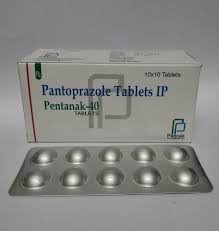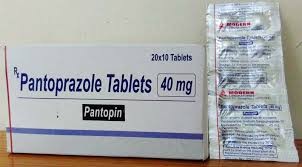Pantoprazole belongs to the class of medicines called the proton pump inhibitors or more easily PPI. Now before moving into details about pantoprazole let us get to know more about PPI.

PROTON PUMP INHIBITORS.
In simple words they are the drugs that decrease the acid secretions in the stomach, scientifically speaking they inhibit the H+/ATPase pump. This H+/ATPase pump is known as the proton pump of the stomach, it exchanges the potassium ion present in the lumen of the intestine with the H+ ion present in the cytoplasm and results in the acidification of the stomach, and it is also responsible for the activation of pepsin, the digestive enzyme. Now proton pump inhibitors inhibit this pump resulting in the decrease in the acidification of the stomach. They irreversibly block the pump that is located in the gastric parietal cells and thereby causing a prolonged reduction in the gastric acid.
USES OF PANTOPRAZOLE
Pantoprazole is mainly used in diseases that require the reduction in the secretion of gastric acid-like, acid reflux diseases such as:
- Gastroesophageal reflux disease (GERD).
- Zollinger Ellison syndrome (ZES).
- Erosive esophagitis.
- And various other hypersecretory conditions
- Ulcers
Pantoprazole is prescribed widely by physicians along with other medications to relieve the patients from the conditions that cause excess acid secretions caused by the action of the main drug that is being administered.
MECHANISM OF ACTION OF PANTOPRAZOLE

It irreversibly blocks or inhibits the H+/ATPase pump in the gastric parietal cells, thereby decreasing the excess gastric acid mainly hydrochloric acid secretion and resultant acid reflux. In general it is a proton pump inhibitor.
PHARMACOKINETICS OF PANTOPRAZOLE
- Pantoprazole is mainly available as oral and i.v dosage forms since this drug is highly acid unstable, it is prepared as enteric-coated tablets and care should be taken not to crush the tablets.
- Followed by the oral administration of the drug it is very well absorbed.
- Its bioavailability is approximately 77% and has a volume of distribution of 11.0-23.6L. It has a life of 1.1 hours.
- The metabolism of the drug is mainly by the liver that too mainly by the CYP-450 system, undergoes only limited first-pass metabolism.
- Finally it is excreted as metabolites through urine.
- Summarizing: the absorption, distribution, metabolism, and elimination of pantoprazole is as follows
Absorption (A): very well absorbed orally
Distribution (D): bioavailability of 77% and volume
Of distribution of 11.0-23.6L
Metabolism (M): mainly by the liver
Excretion (E): as metabolites in urine.
SIDE EFFECTS OF PANTOPRAZOLE
Long term use of pantoprazole can cause:
- Atrophic gastritis: it is the chronic inflammation of the stomach lining
- Hypomagnesaemia: decrease in the level of serum magnesium in the blood.
- Fundic gland polyps: it is a medical condition where the fundus and body of stomach develops many polyps, these polyps can become cancerous
- Severe diarrhea
- Allergic symptoms: various allergic symptoms occurring due to the chronic usage of pantoprazole include :
- Nausea, vomiting
- Fever
- Rashes
- Bloating
- Confusion etc. …..
- Fever and presence of blood in mucus or stool can occur as a side effect.
- After long term use of pantoprazole there are chances for vitamin b 12 deficiency to occur.
- Long term use can also cause conditions like: bone damage, kidney damage, and cutaneous lupus erythematosus, systemic lupus erythematous.
- When it is given through IV route there are chances for injection site reactions to occur.
- Other side effects include dizziness, drowsiness, joint pain, insomnia.
CONTRAINDICATIONS OF PANTOPRAZOLE
The conditions where pantoprazole should be avoided include:
- Diarrhea due to clostridium deficiency
- Patients having vitamin b12 deficiency should not use this drug as it can exacerbate the condition.
- Patients with low magnesium level should avoid the drug
- Cases of interstitial nephritis.
- Patients are known to have cutaneous lupus erythematosus or systemic lupus erythematous.
- Osteoporosis patients should not take this drug.
- It is contraindicated in breastfeeding.
- During pregnancy it should be taken only when directed by the physician.
INTERACTIONS OF PANTOPRAZOLE
Since it has a lower affinity for CYP450 the interactions of pantoprazole with other drugs are usually low when compared to omeprazole or lansoprazole. The various drugs that interact with pantoprazole include:
- Aminophylline
- Ampicillin
- Bisphosphonates
- Clopidogrel
- Drugs for HIV
- Iron supplements
- Methotrexate
- Diuretics
- Warfarin
GENERAL DETAILS ABOUT PANTOPRAZOLE
- Other alternatives for the drug mainly include:
- Omeprazole
- Lansoprazole
- Esomeprazole
- Rabeprazole
- Pantoprazole should be taken 30 mins prior to food
- It should not be chewed or crushed
- Should be stored in room temperature
- The daily dose is 40mg twice a day and a maximum dose of 240 mg.
- It is more acid-stable and has higher oral bioavailability.
- Pantoprazole is usually given as prophylaxis for acute stress ulcers.
S- PANTOPRAZOLE
It is the active single enantiomer twice as potent as the racemate. Usage of S- pantoprazole in pregnancy and breastfeeding is not advisable.
- It is not recommended to use in cases where the patient is allergic to the drug.
- Dose titration must be suitably done in case of liver diseases.
- Long term use of the drug can cause decreased absorption of vitamin B12, so supplement should be taken with a doctor’s consultation.
- It should be taken on an empty stomach.
- Care should be taken as it can cause sleepiness.